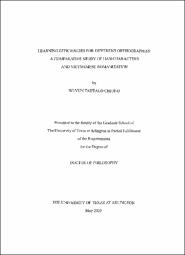
ATTENTION: The works hosted here are being migrated to a new repository that will consolidate resources, improve discoverability, and better show UTA's research impact on the global community. We will update authors as the migration progresses. Please see MavMatrix for more information.
Show simple item record
| dc.contributor.author | Chiung, Wi-Vun Taiffalo | |
| dc.date.accessioned | 2021-02-12T14:28:47Z | |
| dc.date.available | 2021-02-12T14:28:47Z | |
| dc.date.issued | 2003-05 | |
| dc.identifier.uri | http://hdl.handle.net/10106/29693 | |
| dc.description.abstract | In order to address the question of whether or not to abandon Han characters (Hanji), it is important to evaluate empirically the efficiency of Han writing. The purpose of this study is to compare the efficiency of learning to read and write in Hanji versus learning to read and write in phonemic writing systems, such as Vietnamese Chu Quoc Ngu (CQN) or Mandarin Bopomo. Three experiments were conducted in this study. The first experiment focused on a study of reading comprehension; the second one focused on a study of accuracy of writing dictation; and the last was a study of oral reading. A total of 453 subjects from Taiwan and 350 subjects from Vietnam were involved in the experiments. Subjects consisted of elementary school and college students. The reading comprehension tests were divided into groups Hanji, Bopomo, and CQN, in which subjects were examined with reading texts in Hanji, Bopomo, and CQN, respectively. The results of the reading comprehension tests reveal no statistically significant difference between Hanji and CQN groups. However, students from the second to fifth grades in the Bopomo group had significantly lower scores than students in the other groups. In dictation tests, subjects were divided into groups Taiwanese and Vietnamese. Tests in each group were given in soft and hard articles. The statistical results of tests on soft article reveal that students in both Taiwanese and Vietnamese groups significantly increased their score each year until the fourth grade, by which time they had the same statistical score as college students. As for tests on hard article, Taiwanese students spent more years in the acquisition of Hanji, and even the sixth graders' scores do not statistically reach the same level as college students. However, Vietnamese students had reached a college level at the fifth grade. Errors in the dictation tests were also analyzed, and twelve error types were found in the Taiwanese group. The major errors were made due to similarity in sound between correct and incorrect Han characters. The phonetic similarity errors account for 85.70% in the dictation test two. In addition to dictation tests, CQN also showed superiority in oral reading tests. The results indicate that CQN beginners are able to produce about 90% accuracy in oral reading after three or four months of learning, and reach nearly 100% accuracy a year later. In short, these results lead to the conclusion that Vietnamese CQN is more efficient than Chinese characters in learning to read and write. | en_US |
| dc.language.iso | en_US | en_US |
| dc.publisher | University of Texas at Arlington | en_US |
| dc.subject | Linguistics | en_US |
| dc.subject | Bilingual education | en_US |
| dc.subject | Multicultural education | en_US |
| dc.subject | Asian studies | en_US |
| dc.title | LEARNING EFFICIENCIES FOR DIFFERENT ORTHOGRAPHIES: A COMPARATIVE STUDY OF HAN CHARACTERS AND VIETNAMESE ROMANIZATION | en_US |
| dc.type | Thesis | en_US |
| thesis.degree.department | Linguistics | |
| thesis.degree.name | Doctor of Philosophy in Linguistics | |
Files in this item
- Name:
- Learning Efficiencies for Different ...
- Size:
- 29.88Mb
- Format:
- PDF
- Description:
- PDF
This item appears in the following Collection(s)
Show simple item record


